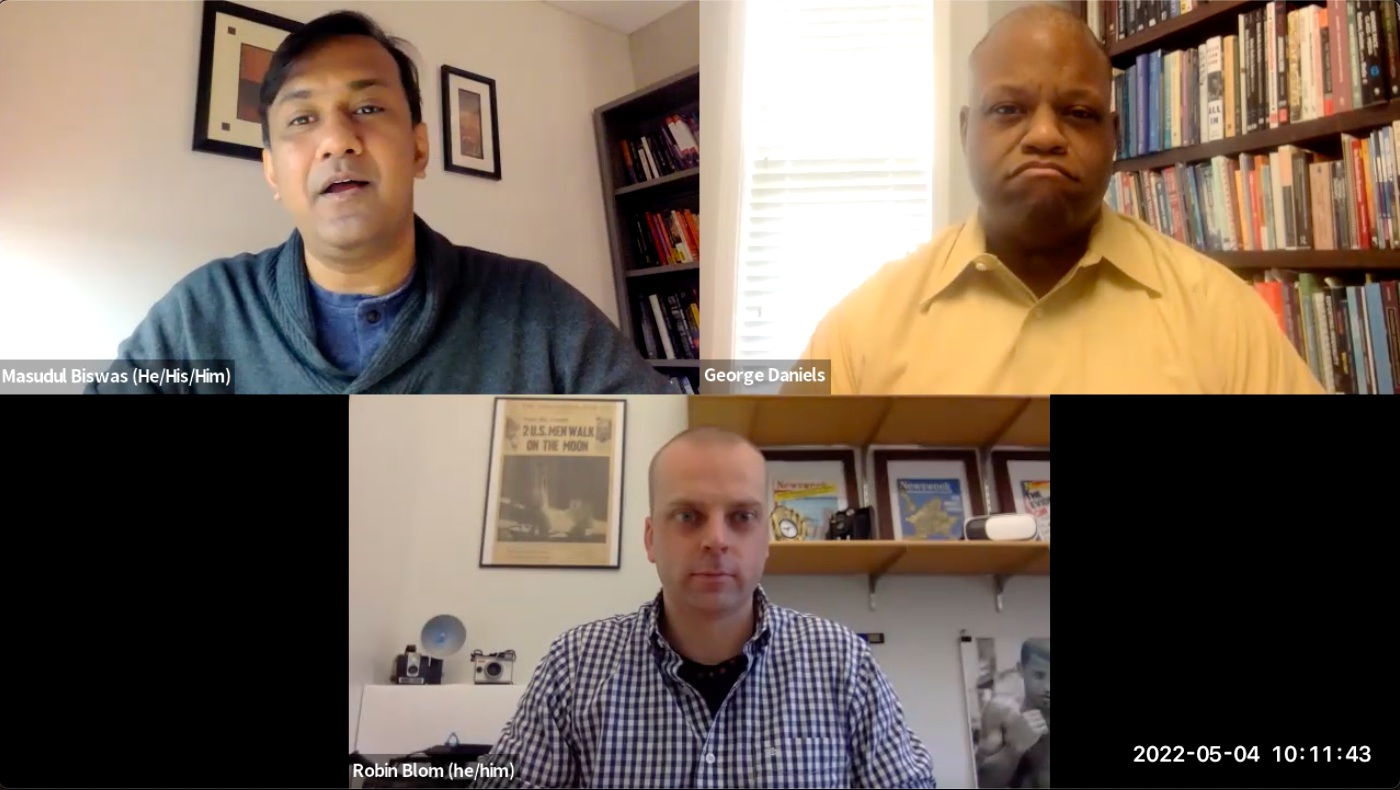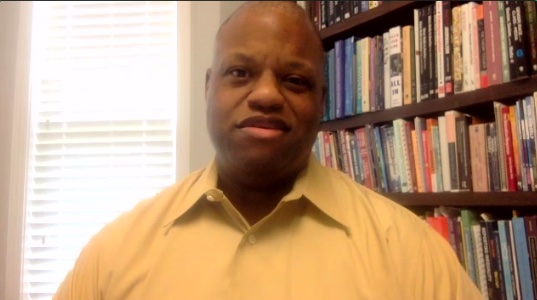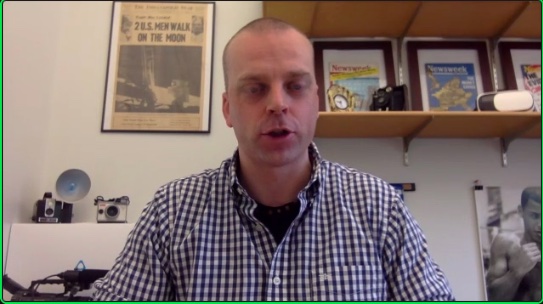Why is this book? How do JMC faculty can use this book?
by Masudul Biswas
George Daniels and Robin Blom, editors of Teaching Race: Struggles, Strategies, and Scholarship for the Mass Communication Classroom, took an unique approach to document how journalism and mass communication (JMC) faculty from various backgrounds teach and address race in classrooms while acknowledging their challenges.
Dr. George Daniels is an associate professor journalism and former assistant dean of assessment, accreditation and diversity at The University of Alabama's College of Communication and Information Sciences. Dr. Robin Blom is an associate professor of journalism at Ball State University's School of Journalism and Strategic Communication.

Tell us the story behind this book. Why did you decide to propose this book?
George Daniels [George]: We are delighted to share the story of this project that I would argue started with some ideas that were floating in my mind, probably back in 2018. I had a vision for a book that would recap some of the experiences that I had as a teacher teaching three diversity classes at Alabama. One of these courses was race, gender, and media.
Another diversity course that I taught was an undergraduate course in mass communication, service and diversity. Both of these were undergraduate courses that I taught every other spring semester for about five or six years. About five years ago, I was challenged to put together a graduate level course on diversity and communication with a focus on how we do research on diversity in the media. In our regular skills classes, such as news reporting, electronic news writing and editing, we talk about diversity. So I was thinking, in all these different contexts, I've been teaching about diversity, but I really have never written down the experiences. This thinking helped me to generate an outline of what I wanted this book to be. And I just put it in my journal and left it there. In 2019, when I was vice-head or head of the AEJMC's Minorities and Communication (MAC) Division, Chris Roush, who started the masterclass series with a book when he was chair of the AEJMC's elected committee on teaching asked whether the MAC division and I would be interested in putting together a book about how we teach diversity.
Since they wanted to have more books in this series and MAC division has a lot of people who do this kind of work, I sent out a general call through MAC list serv and got some replies to that call. We got a committee together and put together some ideas. For this book project, I also really wanted to work with Robin Blom, who was very productive in producing scholarship in pedagogy and in our main teaching journal, Journalism & Mass Communication Educator. A friend of mine, research partner and colleague Gabriel Tate is Robin's colleague. Gabriel got me connected me with Robin and participated in our initial discussions about the book.
This is how we began putting together this book. This book was not result of people just submitting chapter proposals to us. We already had in mind what we wanted this book to look like.
Robin Blom [Robin]: First time when I met with George was at my first AEJMC conference; it was the Midwinter Conference in Reno. I think George was the first or second person I got introduced to by my graduate director, Dr. Dane Claussen. So I was excited to hear through my colleague, Gabriel, that George would like to collaborate on a book project with me.
George quickly developed a list of topics for the book. I added my own little spin to it by adding or combining certain topics. In two meetings, we finalized the chapter outline.
George: We wanted our MAC Division members to be the writers for this project, because as we approached the 50th anniversary of the division, one of the things we noticed is there's a lot of wisdom on how to teach diversity in this division. And we didn't think that we had showcased that wisdom enough. We had a pre-conference a few years ago when Sharon Bramlett-Solomon had put together teaching diversity class online and in person. You can have panels year after year, but how do you bring that wisdom together in a place where people can reference it when they need to put together a class quickly while dealing with controversies that will pop up. Diversity flareups will happen at the national level, local level or on campus. How do we get teachers ready to be able to handle those in the classroom? That's really what we tried to deal with in this project.
Your book includes a "perspective" essay following each chapter. Why did you decide to structure the book this way?
Robin: We planned for a responding essay for each chapter. This allowed us to include more scholars, more perspectives and cover certain topics that are rarely discussed but pivotal to teaching race in depth. We were able to include 22 authors beyond ourselves as editors.
It is the idea that I got from communication yearbooks (later it became a different journal). This publication used to include multiple response pieces from other scholars to each article which I thought was a very neat way to add more perspectives. It was very difficult for us to come up with topics, too, because there's a bunch of them that didn't make it to the book. For example, we did not talk about the ethnic press and things like that. Adding a perspective essay to each chapter allowed us to cover more ground and have a more inclusive presentation of the book.
And those perspectives were more oriented around faculty teaching experiences?

George: Absolutely. The idea is that you can introduce a topic. Well, everyone really shared some aspect of personal experience, but with the perspectives, you're able to emphasize that and provide less depth of discussion about the topic and more about the practice of it and how it plays out in an actual teaching context. For instance, if you were talking about teaching at an HBCU, you can discuss that as a white instructor or as an African-American instructor. A white instructor is going to approach the material and the teaching context very differently from an African American professor. At the same time, if you teach diversity in an advertising class, you will have a different disciplinary or professional connection and experience to share than someone who might be teaching diversity in a journalism class.
I think that those experiences complement each other really well, but more importantly, as Robin mentioned, it gets more voices into the conversation. And such conversation is richer when there are people from different racial and ethnic backgrounds, types of institutions and regions of the country. Among the authors, we had faculty teaching 10 and 12 years and those who've only been in teaching for a few years or a year. We were very intentional about who we invited because we wanted to get some new voices while drawing from some of the wisdom that we know we have in our MAC division.
How is your book different from other similar work on pedagogy?
George: There are no shortage of books on teaching race. In fact, there's a third one on a very similar topic that came out around the same time as ours. So, the question is, why do we need another book about teaching race? Well, we understand that in our field of journalism and mass communication or communications, depending on the unit, there are so many things that are unique to what we're doing in preparing media professionals, whether they be in journalism or in film or in public relations, whether they are on air or off air. So, it is not a problem to have more books on teaching race, especially when they are oriented toward our area of work.
One of the things that we tried to place emphasis on is there is a scholarship of teaching and learning. No matter how many books are out there, we don't have enough documentation of teaching practices. Hence, we asked each of the book chapter authors, and even some of the perspective writers, to also share a pedagogical example and reflections about that. Even in the introduction chapter of the book, we talk about an experience in a couple of different classes where we've been teaching race, what we learned, what worked, what didn't work. That's where the scholarship of teaching and learning is embedded in this project. I don't know whether all other pedagogical books addressed such scholarship as directly as we did.
Could you elaborate on how this book will benefit faculty teaching race and media or those who infuse diversity in other journalism and mass communication courses?

Robin: The book covers three areas. The first one is more looking at structural issues such as how to change curriculum. The second one is looking at the personality, the individuals in the classroom in relation to contexts such as the institution they work, the type of students, and diversity of their students. The last area examines mentorship, research and scholarship. There are so many elements in this book that can be applied to different types of course settings.
When we were working on this book, we literally saw the chaos on the U.S. Capitol. I told George that we probably should pay attention to the major repercussions of this insurrection for the debate on race, which ended up becoming an Afterward (by Deb Aikat) of our book.
This book not necessarily focused on a particular topic, but you can apply these kinds of discussions in all kinds of classrooms. For example, how we engage students in a way that is productive and is not hurting anyone, but still we can have an honest discussion about things that are happening. Also, this book offers ideas on how we can learn from the mistakes that we make during those discussions. So, I think that’s an important area for the book that it can be applied to so many different topics.
George: That afterward is about insurrection injustice and our racial reckonings, and Deb had a lot more to say. Unfortunately, those didn't make it in the book because we were scrambling to get everything finished. But the section he has on disputing the dominant narrative with counter narratives is especially relevant for the discussion about the current debate on what the Supreme court will do with the Roe v. Wade. We don't know what the outcome will be, but what we want to do in a situation like this is help our students understand. What they may be hearing in the media may need to be challenged and they need to be prepared to challenge that and understand where race plays into the discussion. That discussion may be across gender lines, but it also could be across class lines, it also could be across race lines, and it also could be across geographic lines.
Additionally, you can look at what Meta Carstarphen offered in her chapter on the crisis that happened in Tulsa and how she ran a class in the midst of the celebration of the 100 years since the massacre in Tulsa and how you offer a pedagogy that addresses the pain. It is another example of how you can teach a very emotionally-charged topic like abortion or reproductive rights, unpack it and put certain things out on the table. And, at the same time, you teach students how to a report and how to do research. They're many things you can do with that but the key is to have the courage as an instructor as you need to put your own biases and your own experiences out there and know how to handle them.
Robin: And, I'll add to that. For instance, Keonte Coleman in his perspective describes how he set the parameters in class and how that's been very helpful. I have been using his parameters in my class ever since because it accommodates how everyone can participate in discussion that could become heated without any escalation. All the debate is geared to the instructor rather than students or yelling at each other. In his perspective, he also mentioned brought up situations and questions that you haven't thought about before. There's a lot of examples that are very easy to incorporate into your own classes.
How do you see your book playing a role in journalism and mass communication program's initiatives with Diversity, Equity and Inclusion?
Robin: We always considered this book is the beginning of continued discussion on DEI. That's why we keep talking about it through conference panels, seeing what has changed, and sharing what different ways we evolved with our pedagogical practices after the publication of this book. For instance, Keonte's work has been very influential for how I structure my classroom discussion. We'll keep on having panel discussions in the future conferences to continue refining teaching practices around diversity, such as application of intersectional theory discussed in Ilia Rodriguez's chapter that will be elaborated on in the AEJMC's upcoming theory colloquium.
George: Chapter three, committing to excellence in diversity and accreditation, is an absolute imperative for a JMC program. We know that academic units that are accredited by the Accrediting Council on Education in Journalism and Mass Communications will find this chapter useful as the changes in diversity standards will take effect in fall 2022. Teams that are reviewing programs for re-accreditation or initial accreditation will be applying the new revised diversity and inclusiveness standard. In addition to infusing diversity across the curriculum, the revised standard will require a JMC program to provide evidence on faculty training on diversity.
This book is a great starter for that training since it addresses question such as “What do I do to prepare to teach this particular topic?” I think this new accreditation requirement is going to change programs beyond individual classes by offering a culture of training and professional development around race. Diversity, equity and inclusion has to be going on in all of our 113 or 114 accredited units. So, we hope that this book will be a resource that faculty will put to work as they organize training. Keeping that in mind, we are thinking about developing some materials such as podcasts based on book chapters and associated perspectives.
In August, I've been invited to do a workshop for high school teachers in the Detroit area. We know that teaching race is not just happening at the college level but also at high school level. So, we're going to provide teachers who are part of the AJMC Scholastic journalism the wisdom of the faculty who contributed to teaching race. And that is the kind of thing we want to see built from that. So that's going to change programs and universities. As we reach beyond university campuses, we, also, can change education at other levels also.
Robin: I will say that, in addition to the accreditation chapter, Daniel Brown's first chapter of the book talking about changes that need to happen in a JMC program is a mandatory reading for any administrator running programs, designing curricula because that's where it all starts.
Anything that you would like to add that I did not raise, or you forgot to mention?
George: If a JMC program would like for us to come to their campus or even do something virtual on some of the topics that we covered in Teaching Race book, we are always excited to do that. And, I'm sure any of the contributors on the team will be willing to do that as well.
Robin: All the royalties from this book is going to the MAC division so that the group can support faculty and graduate students with this kind of research through grants.
